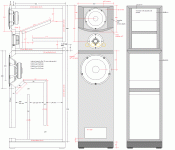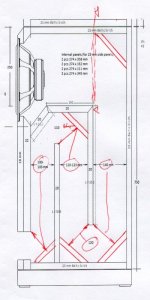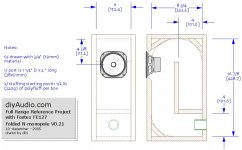Im just planning to build this one with TL enclosure for the CA26RFX so anybody has any reviews about it?
One thing observed with the above one is that TL has got reduced crosssection for every chamber till the vent.
But overall how does it sound do you have the bottom end deep enough and low distortion?
One thing observed with the above one is that TL has got reduced crosssection for every chamber till the vent.
But overall how does it sound do you have the bottom end deep enough and low distortion?
Attachments
The design mimics a tapered TL line. What I would suggest is adding 45° panels in the corners to help with the airflow (see attached). The throat in this area should be the same as the proceeding line.
I can't comment on the CA26RFX as I've never used it but thought it was good enough for the diyAudio 3-way thread and there are plenty of positive comments about this driver. If the vented design has good potential bass performance I can't see why a well designed TL shouldn't be the same.
http://www.diyaudio.com/forums/multi-way/153415-diy-audio-3-way-reference-project-10.html#post2005713
I can't comment on the CA26RFX as I've never used it but thought it was good enough for the diyAudio 3-way thread and there are plenty of positive comments about this driver. If the vented design has good potential bass performance I can't see why a well designed TL shouldn't be the same.
http://www.diyaudio.com/forums/multi-way/153415-diy-audio-3-way-reference-project-10.html#post2005713
Attachments
What I would suggest is adding 45° panels in the corners to help with the airflow (see attached).
Those have been shown to be counterproductive.
dave
As Dave said, the angled deflectors don't provide any benefits. Angled deflectors like these go way back in thinking; they were thought to help "steer" the sound around corners and bends, but the frequencies of concern (the bass) have such long wavelengths that they don't even "see" those reflectors. I haven't heard this Troels' design but for both the woofer and midrange TLs, the drivers are located at the very beginning of the lines, which is a poor location unless the driver is being crossed low, like for a subwoofer. The TL for the CA26, however, may be okay depending on the crossover corner.
Paul
Paul
Can you give me any more info/details on that, please?Those have been shown to be counterproductive.
dave
I'm not speaking for Dave but I already described why the angled reflectors aren't at all useful for the original but incorrect reasons people used them. Furthermore they reduce the line's volume somewhat which detrimentally affects bass response, although minor.
Paul
Paul
Can you give me any more info/details on that, please?
Can you give me any more info/details on that, please?
Besides what Paul said, the expansion at the folds with no deflectors act as low-pass filters, helping to reduce the unwanted ripple from the higher up line harmonics.
dave
I'm not speaking for Dave but I already described why the angled reflectors aren't at all useful for the original but incorrect reasons people used them. Furthermore they reduce the line's volume somewhat which detrimentally affects bass response, although minor.
Paul
Ah well, it's a pity mine have them in, then. But how about the the one behind the driver? Doesn't that act as a diverter, reflecting the higher frequencies down the line, rather than back at the driver?Besides what Paul said, the expansion at the folds with no deflectors act as low-pass filters, helping to reduce the unwanted ripple from the higher up line harmonics.
dave
But how about the the one behind the driver? Doesn't that act as a diverter, reflecting the higher frequencies down the line, rather than back at the driver?
Maybe. How high does the driver in the TL go? How much damping just behind the driver?
dave
Not a lot just behind the driver, but more at the start of the throat. And the walls of the rear chamber are well lagged, felt and BAF wadding.Maybe. How high does the driver in the TL go? How much damping just behind the driver?
dave
The speakers are Troels' Jenzen SEAS ER, with the NEXT mid driver and NEXT MF/HF crossover. Unfortunately I cannot move them around to find the best positioning for room nodes, so I will just have to try to tailor the line stuffing for best effect. They cross over at just over 200Hz, it appears.
And crossover component quality makes a BIG difference to the sound.
An externally hosted image should be here but it was not working when we last tested it.
Last edited:
Yes Dave and Paul, I'm a bit old school and haven't looked at TL's in over a decade. Back then I was more concerned with smooth airflow and more important, having the throat size consistent (i.e. not increasing at bends). Probably goes back to my engineering days decades ago as was good practice with hydraulics and fluids.
I've seen them built both ways with and without 45° panels in the corner. I did build a single trial box for a FE127 back in 2005. Remember this one Dave as it had the corner panels but I know you've gained more TL knowledge and experience and moved on from this design.
I bow to the up to date TL experts.
Peter
I've seen them built both ways with and without 45° panels in the corner. I did build a single trial box for a FE127 back in 2005. Remember this one Dave as it had the corner panels but I know you've gained more TL knowledge and experience and moved on from this design.
I bow to the up to date TL experts.
Peter
Attachments
- Status
- This old topic is closed. If you want to reopen this topic, contact a moderator using the "Report Post" button.
- Home
- Loudspeakers
- Multi-Way
- Did anybody built this TL frm Torels with Seas CA26RFX


